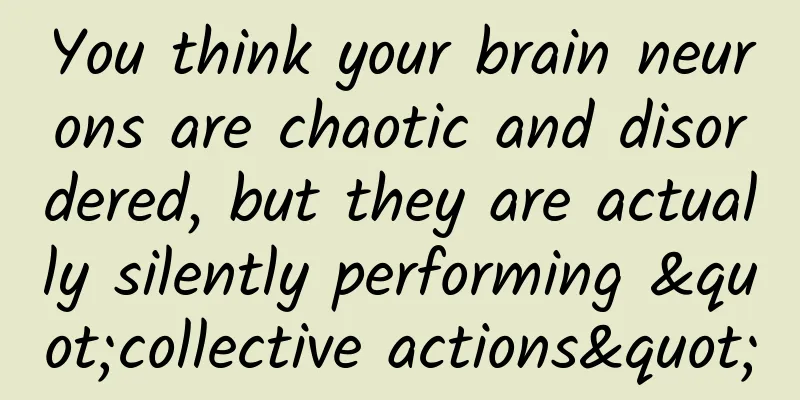You think your brain neurons are chaotic and disordered, but they are actually silently performing "collective actions"

|
Wang Linlin Liu Chuanbo Understanding how the brain works has always been a huge challenge in scientific exploration. Recently, a research team from Google and Harvard University jointly published a groundbreaking research result in the international journal Science. This study successfully modeled the human brain with nanometer-level precision, constructed the largest electron microscope image data set and the highest-resolution human brain synaptic connection map to date. This breakthrough not only shows the fine structure of the complex connections of the human brain, but also provides the possibility for in-depth analysis of brain function and treatment of related diseases in the future. The researchers cut a 1 cubic millimeter tissue sample from the temporal cortex of a 45-year-old epilepsy patient at the nanoscale and used a scanning electron microscope to image it, obtaining a total of about 1.4PB (1.4 trillion bytes) of image data. How huge is this amount of data? It can be said that even if all the computers in the world are used for storage, it is only enough to store image data of about 9 human brains. By performing detailed neuronal morphological segmentation and cell structure reconstruction on these image data, scientists have successfully identified more than 57,000 cell nuclei and 150 million synapses. Based on these data, the number of synapses in the entire brain may be as high as tens of trillions. In comparison, the number of parameters of the world's largest artificial neural network is less than 10 trillion, which is only equivalent to the complexity of a 1 cubic centimeter area in the brain. Scientists have found that although the brain has up to 86 billion neurons, these neurons do not work independently, but tend to act collectively. We can compare this phenomenon to students on the playground: during free time, students do their own things and the scene is very chaotic. Suppose there are 100 students, and each student needs two coordinates to represent, then a total of 200 coordinates are required, that is, a 200-dimensional space is constructed. However, in physical education class, when all students run together, they form an orderly queue, and this queue can be described with far fewer than 200 coordinates. Assuming that students in both classes are doing collective activities, only four dimensions are enough to approximately describe the movement of all students. This situation can be compared to the collective activity of neurons in the brain, that is, brain activity can be represented in a low-dimensional space. This low-dimensional space is directly related to the function and behavior of the brain, and this theory is also called the "neural manifold model." Recently, the brain science journal Neuron published online the latest research results from Rockefeller University in the United States. Through in-depth statistical analysis, scientists found that as the number of neurons increased, the dimensions of the collective motor behavior of neurons in the cerebral cortex showed unlimited growth. The study found that 16 of the dimensions were closely related to the motor behavior of mice, while other high dimensions seemed to be related to some internal activities that could not be directly mapped to specific motor behaviors. These hidden dimensions exhibit continuous time scale characteristics, and their signals are distributed throughout the cerebral cortex. This discovery reveals that these hidden dimensions may be closely related to information transmission and processing in the cerebral cortex, and are the key to internal calculations and adaptive behaviors of the brain's neural network. Scientists speculate that the brain's seemingly redundant design may be intended to achieve an effective balance between stability, efficiency and adaptability. By studying the connection network of neurons in the brain and their collective actions, we can gain a deeper understanding of how the brain works efficiently. This understanding not only reveals the complex mechanism of how the brain processes information, but also provides us with new possibilities for simulating brain functions and treating neurological diseases. A deep understanding of the motor behavior of the brain will not only help us deal with various neurological diseases, but also promote the design of more efficient computing hardware and the development of advanced brain-computer interfaces, thereby establishing a smoother communication channel between humans and machines. By simulating the way neurons work, scientists can design new types of computing models. These models may surpass existing electronic computers in processing speed and efficiency. (The author Wang Linlin is a member of the Jilin Province Science Popularization Creation Association and an assistant researcher at the Jilin Province Science and Technology Workers Service Center; Liu Chuanbo is a member of the Jilin Province Science Popularization Creation Association and a doctor at the Changchun Institute of Applied Chemistry, Chinese Academy of Sciences) |
<<: Super-large sunspots return, will geomagnetic storms and auroras appear again?
>>: Summer is here, why are my mosquito bites always rounder and more itchy than others?
Recommend
Breaking through the Western technology blockade, her research has made fluorescent lamps light up thousands of households
There has never been a lack of great women on the...
One pound of durian contains two pounds of "carbon". How do agricultural scientists measure carbon emissions reduction for domestic durian?
Xinhua News Agency Haikou, July 21 (Reporter Chen...
Can Douyu and Huya rely on cloud gaming to return to the top?
Once upon a time, when people in China mentioned ...
Several reasons why the effect of Baidu's bidding promotion suddenly declined!
As the effect of Baidu bidding hosting promotion ...
How to make users addicted to your product? 5 steps!
"Information overload" is the current s...
An old man in the park "hangs" himself on the horizontal bar. Is it to treat cervical spondylosis?
Audit expert: Wang Linjue Deputy Chief Physician,...
A widget dancing on a needle with shackles on its legs
Since iOS 10, when Apple made a major revision to...
The Lord of the Rings/The Lord of the Rings 1-3 Collection (Blu-ray Ultra HD Extended Edition) Chinese and English Multi-track
"The Lord Of The Rings", also known as ...
These major scientific and technological achievements were praised in the government work report.
On March 13, the two sessions of the National Peo...
iOS 17 hidden new features: enhanced Siri suggestions, calling Apple Watch, etc.
On June 7, Apple released the first developer bet...
Why do people get carsick? | Graphic Science
Sometimes, the difference between people is that ...
24%! Porsche's sales plummeted, and so did the brand recognition of Chinese high-end car owners.
Recently, Porsche China issued a joint statement ...
Baidu Ai Procurement Operation, what should we pay attention to when operating Baidu Ai Procurement?
Since Baidu launched Baidu Ai Procurement , many ...
Google: 10 rules you must know to build a great mobile app
The differences between iOS and Android are the r...
Node.js 4.0.0 is here, ECMAScript 6 is back
The latest upgraded version of server-side JavaSc...









